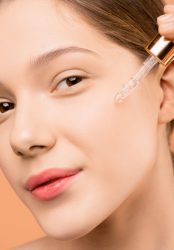The human attraction to beautiful skin is a natural instinct that has been observed throughout history. Beautiful skin has been associated with good health, vitality, and fertility, making it a desirable trait in a potential mate. In this article, we will explore the science behind our attraction to beautiful skin and how we can achieve healthy, glowing skin.
Evolutionary Factors
Our attraction to beautiful skin can be traced back to our evolutionary history. Studies have shown that healthy skin is a sign of good health and fertility, making it an attractive trait to others. Clear, even-toned skin is an indication of a healthy immune system and good nutrition, while blemished or discolored skin may signal underlying health problems.
The Science of Beautiful Skin
Achieving beautiful skin requires a combination of healthy lifestyle habits and skincare practices. A healthy diet rich in fruits, vegetables, and healthy fats can provide your skin with the essential nutrients it needs to stay healthy and glowing. Hydration is also important, as drinking plenty of water can help flush toxins from your body and keep your skin hydrated.
Skin health is essential for maintaining overall health and well-being. The skin acts as a barrier, protecting our bodies from harmful environmental factors, regulating our body temperature, and providing sensory feedback. When it comes to topical skincare products, the permeability of the skin plays an important role in their effectiveness. The skin’s outermost layer, the stratum corneum, acts as a barrier, preventing the penetration of harmful substances while allowing the absorption of beneficial ones. Therefore, it’s essential to choose skincare products that are formulated with safe, effective ingredients that can penetrate the skin’s barrier and provide the desired benefits without causing harm.
Understanding Your Skin
Before we dive into skin care tips, it’s essential to understand the basic structure of our skin. Our skin is composed of three layers: the epidermis, dermis, and subcutaneous tissue. The epidermis is the outermost layer of the skin and is responsible for protecting our body from environmental damage, while the dermis is responsible for providing support and nourishment to the epidermis. The subcutaneous tissue is the deepest layer and is responsible for regulating our body temperature.
Tips for Healthy Skin
Now that we understand the basics of our skin’s structure, let’s explore some practical tips for keeping our skin healthy.
Protect your skin from the sun: The sun’s harmful UV rays can cause skin damage, premature aging, and increase your risk of skin cancer. Therefore, it’s crucial to protect your skin by wearing protective clothing, hats, and sunglasses, and using broad-spectrum sunscreens with an SPF of at least 30.
Keep your skin hydrated: Drinking plenty of water and using a moisturizer can help keep your skin hydrated, soft, and supple.
Avoid smoking: Smoking is not only harmful to your overall health, but it can also damage your skin, causing premature aging, wrinkles, and other skin problems.
Eat a healthy diet: A diet rich in fruits, vegetables, lean protein, and healthy fats can provide your skin with the essential nutrients it needs to stay healthy and glowing.
Get enough sleep: Lack of sleep can cause dark circles, puffiness, and other skin problems. Therefore, it’s essential to get enough sleep to help your skin rejuvenate and repair itself.
Manage stress: Chronic stress can lead to skin problems such as acne, eczema, and psoriasis. Therefore, it’s crucial to manage stress through meditation, exercise, or other relaxation techniques.
Avoid harsh skin products: Harsh skin products, such as those with high levels of alcohol or fragrances, can irritate your skin and cause damage. Therefore, it’s essential to use gentle, non-comedogenic products that are suitable for your skin type.
Did you know that our skin is the largest organ in the human body? It plays a vital role in protecting our body from harmful environmental factors, regulating our body temperature, and providing sensory feedback. So let’s take a minute to understand how to maintain the good overall health of our skin.
Skincare practices such as cleansing, exfoliating, and moisturizing can also help improve the appearance of your skin. Cleansing removes dirt, oil, and makeup from your skin, while exfoliating removes dead skin cells and promotes cell turnover. Moisturizing helps to hydrate and protect your skin, locking in moisture and preventing dryness.
In addition to these basic skincare practices, there are many products and treatments available that can help improve the appearance of your skin. Products containing retinoids, antioxidants, and alpha-hydroxy acids can help reduce the appearance of fine lines, wrinkles, and age spots. Treatments such as chemical peels, microdermabrasion, and laser resurfacing can help improve skin texture, tone, and elasticity which we will be discussing in great detail on our journey together to start with beautiful skin every day.
Final Thoughts
Our attraction to beautiful skin is a natural instinct that has evolved over time. Healthy, glowing skin is an indication of good health and fertility, making it a desirable trait in a potential mate. Achieving beautiful skin requires a combination of healthy lifestyle habits and skincare practices, including a healthy diet, hydration, cleansing, exfoliation, moisturizing, and the use of skincare products and treatments. By taking care of our skin, we can improve our overall health, vitality and confidence so let’s start with beautiful skin.




